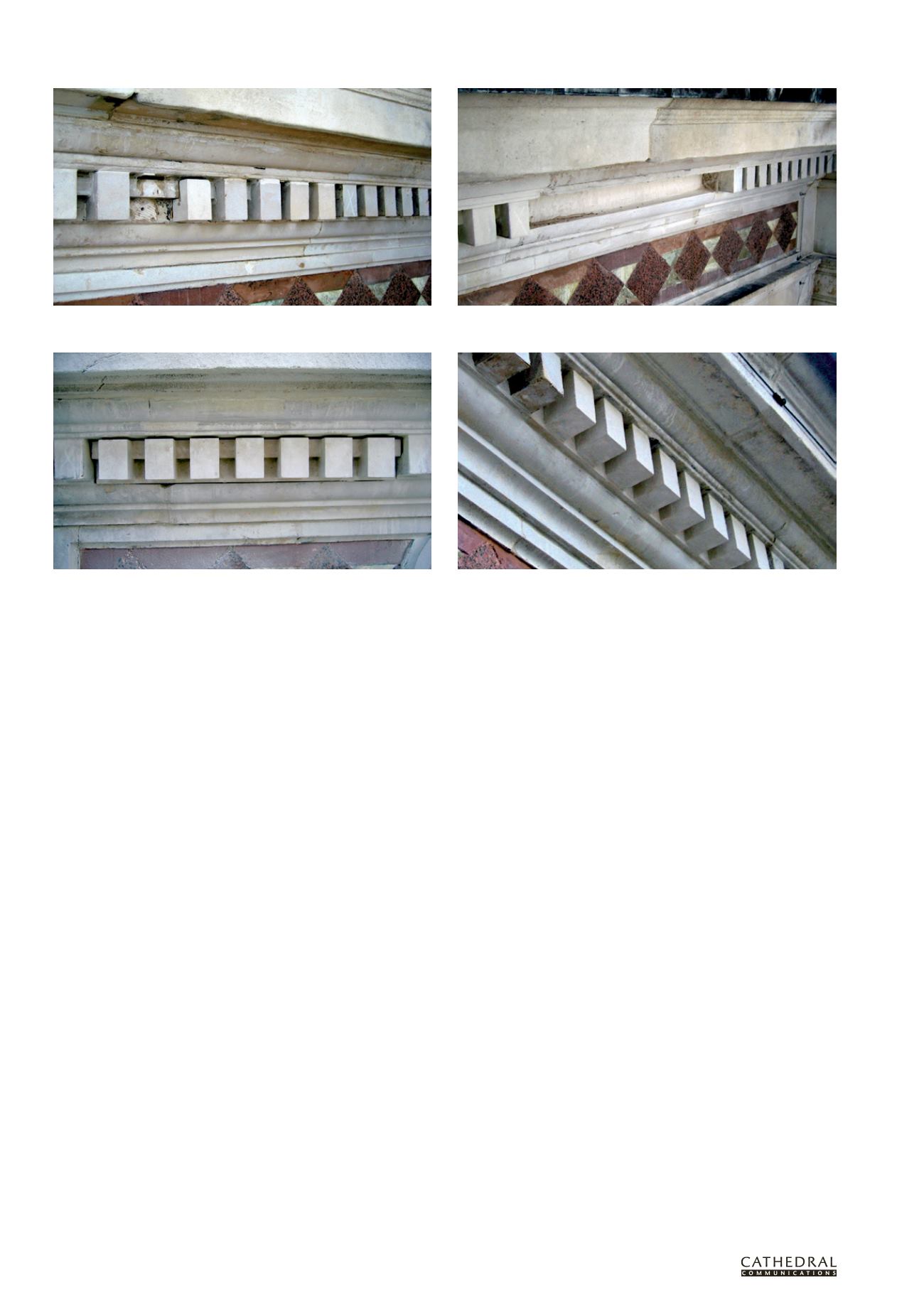

1 5 4
T H E B U I L D I N G C O N S E R VAT I O N D I R E C T O R Y 2 0 1 5
T W E N T Y S E C O N D E D I T I O N
SERV I CES & TREATMENT :
PROTEC T I ON & REMED I AL TREATMENT
4.1
binders are available, from high calcium lime
(with or without additives such as pozzolans
to enhance performance) to natural hydraulic
limes (NHLs) graded from 2 to 5 based on
strength, to suit various exposures.
For both indents and mortar repairs the
damaged surface must be carefully prepared.
Lack of surface preparation and lack of
adequate reinforcement or armature are two
of the most common causes of failure of past
repairs. The stone surface should be cut back
to sufficient depth that the indent or mortar
will remain safely in place and the edges of
the repair cavity undercut to hold the repair.
Although it is often possible in the case of
larger indent repairs to use mechanical (disc)
cutters to remove the bulk of the damaged
stone, the final dressing of the repair cavity,
the back and sides, should be done by hand
with sharp masonry chisels to form well-cut,
neat edges to the repair. The interface between
a stone indent and repaired stone should be
very fine, not a masonry joint, for maximum
durability. Good indent repairs require a high
level of masonry skill. Trials and exemplars
should be part of any repair contract to ensure
at the outset that the required standard can
be achieved. Historic indent repairs of very
high quality are often found on historic
masonry buildings, and are testament to what
is possible. These historic repairs often have a
curved profile, following the edge of a defect to
minimise repair size and avoid the mechanical
appearance that can result when indents are
cut square.
The following general rules should be
observed when carrying out historic masonry
repairs:
• Historic masonry joints must be followed
in all repair and replacement work. If
repairs bridge masonry joints, evidence
of the original construction (joint details)
will be lost, and there is a risk of the
repair fracturing along the joint lines.
• Stone indents to exposed edges, for
example on the nosings of cornices,
steps, and copings, should be
dovetailed in place to secure them.
• In general, indent repairs should be
anchored by dowels (normally corrosion
resistant stainless steel or phosphor
bronze) inserted into fine drillings into
the indent and the back of the repair
cavity, and bonded with resin designed for
this application. Resin should be used in
the drilling only and not smeared across
the stone surfaces at the interface.
• Lime grout is the appropriate material
for bonding the stone interface,
which must be completely filled to
avoid rainwater penetration using
grout specifically designed to suit the
exposure, stone type and colour.
• Both stone indents and replacement
stones should follow the original
profile of mouldings as far as these can
be determined. This can be difficult
with weathered surfaces and evidence
should be sought in the least weathered
areas and profiles recorded onto a
permanent template, such as zinc.
• Mechanical saw marks on stone faces are
completely out of character and should not
be accepted. Stone repair faces should be
finished by hand and dressed to replicate
original tool marks of the historic masonry.
• Masonry joints finished as part of
stone repair and replacement work
should also be visually and physically
compatible with the existing.
Provided these general rules are followed to a
high standard using good masonry skills, repair
work, and in particular indent repairs, should
provide a good long term solution and enhance
rather than detract from the historic masonry.
Recommended Reading
G Allen et al,
Hydraulic Lime Mortar for
Stone, Brick and Block Masonry,
Donhead,
Shaftesbury, 2003
J Ashurst and FG Dimes,
Conservation of
Building and Decorative Stone,
Butterworth-
Heinemann, Oxford, 1998
British Standards Institution,
BS 8221-1:2012
Code of Practice for Cleaning and Surface
Repair of Buildings
, BSI, London, 2012
Ian Brocklebank (ed),
Building Limes in
Conservation
, Donhead, Shaftesbury, 2012
English Heritage,
Practical Building
Conservation: Stone,
Ashgate, Farnham, 2012
CATHERINEWOOLFITT
ACR MIfA is a
conservator and archaeologist specialising
in the care and conservation of ancient
monuments and historic buildings, with
particular emphasis on architectural detail
and sculpture in stone, fired clay and lime
based materials. She holds MA degrees in
classical archaeology and art conservation
and has worked in private practice since 1999.
She established Catherine Woolfitt Associates
(see page 38)
in 2008 and provides technical
advice, consultancy and teaching services in
the conservation of the built heritage.
Dentils in a cornice which had been poorly repaired in the past, with machine
cut dentils that were larger than the originals and inadequately bonded to the
underlying stone with resin and some metal dowels.
After removing the failed replacements, the stone was dressed back to enable a
more effective indent repair with a new section of dentils worked as a single piece
of stone.
The new indent unit loosely slotted into the repair cavity, ready for fixing
The finished piece after fixing with new stainless steel dowels and grouting at the
interface
















